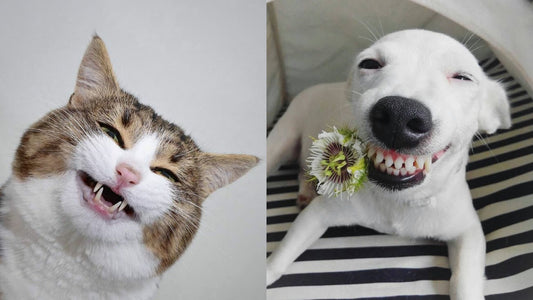Our pets are our furry best friends, and we love nothing more than making them happy and seeing their little tails wag with joy. But how do we know when our pets are happy, anxious, or even feeling a little sick? Well, we just need to learn their body language!
Like humans, animals communicate their emotions and feelings through their body language. By understanding their cues, we can build a deeper connection with them and respond to their needs more effectively. Here are some key body language signals to look out for:
Facial Expressions:
Dogs and cats are highly expressive creatures, and their facial expressions can tell us a lot about how they're feeling. When your pet is relaxed and happy, their face will be soft and their eyes will be relaxed. But when they're anxious or scared, their face may be tense, with their eyes wide open and their mouth closed tightly.
If your pet is feeling a little under the weather, you may notice that their eyes look a little dull, and they may not have their usual bright, alert expression. This can be a sign that they're feeling a little sick or just need some extra love and attention.
Tail Wagging:
Ah, the tail. It's one of the most well-known signals of a happy dog, but did you know that the position of the tail can also indicate other emotions? When your dog is happy, their tail will usually wag vigorously from side to side. But when they're feeling anxious or unsure, their tail may be tucked between their legs, or it may wag more slowly.
Cats also use their tails to communicate their emotions. When your cat's tail is held high and swishing back and forth, they're probably feeling curious and playful. But when their tail is puffed up and held close to their body, they may be feeling scared or threatened.
Posture:
Just like us, our pets use their body posture to communicate their feelings. A confident dog may stand tall with their chest out, while an anxious dog may crouch down or try to make themselves smaller. Similarly, a cat may arch their back and puff up their fur when they're feeling threatened.
Vocalizations:
Our pets also use different vocalizations to communicate with us. A happy dog may bark joyfully, while a cat may meow to greet you or let you know they're hungry. But when our pets are feeling anxious or scared, they may also make different sounds. Dogs may growl or whine, while cats may hiss or yowl.
Eye Contact:
Eye contact is another important aspect of pet body language. A relaxed pet may hold eye contact with you, while an anxious or aggressive pet may look away or avoid eye contact. So, if your pet is avoiding eye contact or seems to be staring at you with a hard gaze, it may be a sign that they're feeling a little uneasy.
Licking:
Finally, some pets use licking as a way to communicate. Dogs may lick your face or hands to show affection or submission, while cats may lick themselves or other cats to groom them or show affection. So, if your pet is showering you with kisses, it's a sure sign that they love you!
Overall, understanding our pets' body language is essential to building a strong and loving relationship with them. By learning their cues and signals, we can respond to their needs more effectively and ensure they're happy and healthy. If you're ever unsure about what your pet is trying to communicate, don't hesitate to consult with a veterinarian or an animal behaviorist. They can help you better understand your pet's unique body language and ensure they're getting the love and attention they need.









